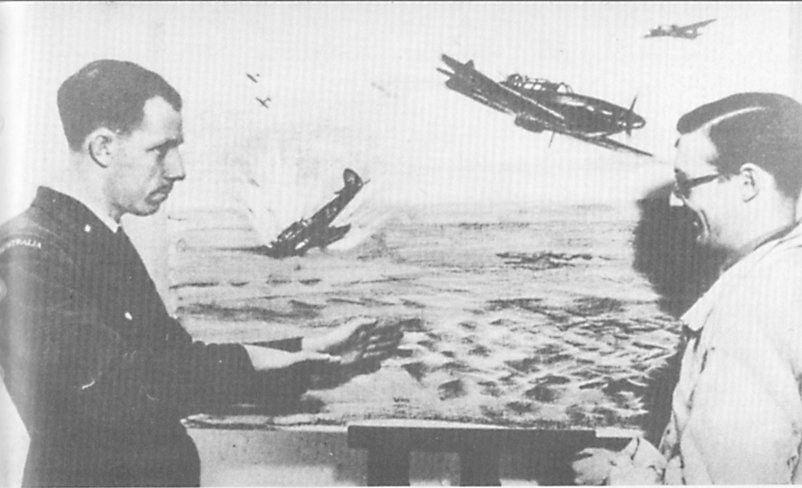For newcomers to the thread, this story begins at post #12692
This story of Sqn Ldr Ian McRitchie was told to me by his daughter Anne, who lives in Australia. I also received considerable information from the late Jack Fishman, author of And the Walls came Tumbling Down, an account of Operation Jericho (Souvenir Press, 1982). Jack travelled to Australia to interview Ian for his book, and told me that he was one of the most interesting men he ever met. -- Geriaviator
AS WELL as being a superb pilot, Ian McRitchie had a well-honed technical mind which he put to work just as soon as he became familiar with Mosquitos. Realising that the aircraft’s existing gunsight was unsuitable, he modified it by removing the optical flap from the sight and projecting the target image directly onto the windscreen, fabricating the necessary brackets in station workshops. It was an early head-up display, no less.
Anyone who knows the RAF knows that such DIY mods are viewed with disapproval. Fortunately he had the ear of Air Vice Marshal Basil Embry, who ordered that Ian’s successful mod should be installed in all the group’s Mosquitos. Embry had survived the 1940 raids which all but wiped out the Blenheim squadrons, having been shot down and escaped from France, and was a thorn in the side of officialdom because he flew all the types used in his wing and would fight his crews’ corner at every opportunity.
He not only approved Ian’s gunsight mods, but ordered it to be fitted to all the 2TAF aircraft. When Ian worked out that the RAF’s standard harmonisation pattern for the aircraft’s four 20mm cannon was inappropriate, he worked out a new pattern and again this mod became the new standard.
Until 1943 RAF night fighters were painted black on the recommendation of Farnborough research scientists, until Ian discovered that none of them had ever flown at night. Not satisfied, he tried different finishes with the help of his aviation artist friend, Roy Nockolds. Their experiments led to Fighter Command changing its night fighter camouflage to a very light grey-green with white along the leading edges, which proved much more difficult to spot against the sky or ground. Coastal Command had the same idea and painted their aircraft white, for oddly enough the Sunderlands, Catalinas and Liberators were rendered extremely difficult to spot among the grey Atlantic skies.
 Aviation artist Roy Nockolds and Ian McRitchie discuss a picture of Ian’s first kill, painted after the two men had produced a successful camouflage scheme for the RAF's night fighters.
Aviation artist Roy Nockolds and Ian McRitchie discuss a picture of Ian’s first kill, painted after the two men had produced a successful camouflage scheme for the RAF's night fighters.
Realising Ian’s true value, Basil Embry tried to have him shifted to a night fighter development unit, but he joined the Armament and Instrument Development Flight instead to work as a researcher and test pilot in the Aerodynamic Flight at Farnborough. There he flew 25 different British, American and German aircraft types and gained the reputation of being innovative and able to find creative answers to technical problems.
Ian’s experience with American aircraft led him to warn Embry that the Vultee Vengeance dive bomber being recommended for the 2nd Tactical Air Force (TAF) was unsuitable for operations in Europe, although designed to a British specification. He said that the Vengeance was too slow, had a poor climb rate and could not carry a sufficient bomb load. (Our much loved contributor Danny 42C, who flew the Vengeance on ops in Burma, would heartily agree with this assessment).
When 12 Allied air officers at a conference tried to force the Vengeance onto Embry, he replied that he would not be a party to his men being killed in the Vultee Vengeance. The discussion became heated until Embry demanded: “Have any of YOU flown the bloody thing?” They replied that they had not. “Well, I have”, said Embry. The top brass received another broadside from Embry, and 2TAF received their Mosquitos.
Ian became increasingly eager to return to operational flying, badgering Embry for a posting. It came on 18th January 1944 when he joined 464 Squadron, the Australian unit at Hunsdon in Hertfordshire to fly the new Mosquito in the 2nd Tactical Air Force. He would be flying Mosquitos again but this time it would be bombers, not night fighters. He quickly adapted himself to bombing techniques and trained his pilots in the versatility of the Mosquitos he knew so well, beginning with a raid on Munster and from February the attacks on the Pas de Calais V-weapon sites.
On February 12 he and his navigator Dick Sampson became separated from the squadron over the Channel and flew alone to their V1 target. Ian lowered the undercarriage to reduce speed and released their delayed-action bombs into the front door of the concrete building through which the V1s would be taken out to the launch ramp. As they climbed away they looked back to see the entire roof of the building rise many feet from its foundations. Nobody believed them on their return to Hunsdon until next day, when a recce Spitfire confirmed the site’s destruction.
Ops continued over the next week until sleet and snow made them impossible, so Ian took a 24-hour pass to visit his wife and nine-month-old daughter Anne -- who would tell me this story 75 years later. On Ian's return his Australian friend Bob Iredale said: “Basil was here and was sorry to have missed you. He briefed us for an important raid due any day”. No more was said, but Ian knew that if Basil Embry had visited to deliver a personal briefing, it would be for something very special.